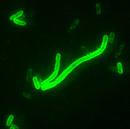CIDPUSA.ORG Yersnia Enterocolitica infection
Yersinia enterocolitica
is a well-described enteric pathogen with distinctive clinical manifestations, a range of outcomes, and a predilection for children. In 1939, Schleifstein and Coleman first described Y enterocolitica. Approximately 75% of patients with Y enterocolitica infection are children aged 5-15 years. The spectrum of disease ranges from asymptomatic to life-threatening sepsis, especially in infants.
Pathophysiology
This organism belongs to the family Enterobacteriaceae, genus Yersinia, which includes 11 species. Three of these species are pathogenic in man: Yersinia pestis (bubonic plague), Yersinia pseudotuberculosis (mesenteric adenitis), and Y enterocolitica. Y enterocolitica is an oxidase-negative, non-lactose-fermenting, gram-negative coccobacillus that is motile at 22C but is not motile at 37C. Biotyping and serotyping can be performed. Of the 34 serotypes of O antigen, types 0:3 (sporadic cases in the United States); 0:5,27; 0:8 (food-borne outbreaks in the United States); and 0:9 are the most common and represent the most virulent worldwide causes of human yersiniosis. Virulence can be chromosomal or via plasmid encoding.
Y enterocolitica infection is more common in cooler climates, and its prevalence peaks from November to January . Y enterocolitica has been isolated in 1.4-2.8% of stools of children with diarrhea. Disease occurs in 1 person per 100,000 population per year in the United States.
- Enterocolitis
- Enterocolitis, the most common presentation, occurs primarily in young children, with a mean age of 24 months.
Prodromal symptoms of listlessness, anorexia, and headache may be present. Such symptoms are followed by watery, mucoid diarrhea (78-96%); fever (43-47%); colicky abdominal pain (22-84%); bloody stools (<10%); and WBCs in the stool (25%).
Complications include appendicitis, diffuse ulceration and inflammation of the small intestine and colon, peritonitis, meningitis, iIntussusception, and cholangitis.
Clinically, suspect Y enterocolitica infection in children with watery, bloody, mucoid diarrhea; a positive stain for WBCs; and exposure to uncooked meat products, particularly pork.
Trimethoprim and sulfamethoxazole (Bactrim, Septra, Sulfatrim)
Continue to medical treatment of Kidney stones Kidney Stone treatment
Antibiotics in ITP
Antibiotics-Cidp
Mycoplasma terror bug
CIDP info
Infection ITP
Turmeric
MMN guide
Autonomic
CIDP Tips
ALS
Lewis Sumner
Most diabetic neuropathy is CIDP
Axonal Polyneuropathy changes in EMG
Learn about
EMG/NCV section
Axonal Polyneuropathy changes in EMG
Currey powder
Services link
Zapper
Magnet therpay
sweetpotatoe.html
Basil